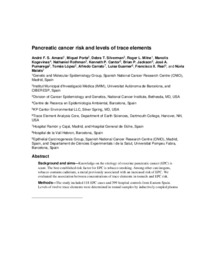Welcome to the UPF Digital Repository
Pancreatic cancer risk and levels of trace elements
JavaScript is disabled for your browser. Some features of this site may not work without it.
| dc.contributor.author | Amaral, André F.S. |
| dc.contributor.author | Porta Serra, Miquel |
| dc.contributor.author | Silverman, Debra T. |
| dc.contributor.author | Milne, Roger L. |
| dc.contributor.author | Kogevinas, Manolis |
| dc.contributor.author | Rothman, Nathaniel |
| dc.contributor.author | Cantor, Kenneth P |
| dc.contributor.author | Jackson, Brian P. |
| dc.contributor.author | Pumarega Rodríguez, José Antonio |
| dc.contributor.author | López, Tomàs |
| dc.contributor.author | Carrato, Alfredo |
| dc.contributor.author | Guarner, Luisa |
| dc.contributor.author | Real, Francisco X. |
| dc.contributor.author | Malats i Riera, Núria |
| dc.date.accessioned | 2019-02-11T08:44:31Z |
| dc.date.available | 2019-02-11T08:44:31Z |
| dc.date.issued | 2012 |
| dc.identifier.citation | Amaral AF, Porta M, Silverman DT, Milne RL, Kogevinas M, Rothman N et al. Pancreatic cancer risk and levels of trace elements. Gut. 2012;61(11):1583-8. DOI: 10.1136/gutjnl-2011-301086 |
| dc.identifier.issn | 0017-5749 |
| dc.identifier.uri | http://hdl.handle.net/10230/36543 |
| dc.description.abstract | Background and Aims: Knowledge on the aetiology of exocrine pancreatic cancer (EPC) is scant. The best established risk factor for EPC is tobacco smoking. Among other carcinogens, tobacco contains cadmium, a metal previously associated with an increased risk of EPC. This study evaluated the association between concentrations of trace elements in toenails and EPC risk. Methods: The study included 118 EPC cases and 399 hospital controls from eastern Spain. Levels of 12 trace elements were determined in toenail samples by inductively coupled plasma mass spectrometry. OR and 95% CI, adjusted for potential confounders, were calculated using logistic regression. Results: Significantly increased risks of EPC were observed among subjects whose concentrations of cadmium (OR 3.58, 95% CI 1.86 to 6.88; ptrend=5×10−6), arsenic (OR 2.02, 95% CI 1.08 to 3.78; ptrend=0.009) and lead (OR 6.26, 95% CI 2.71 to 14.47; ptrend=3×10−5) were in the highest quartile. High concentrations of selenium (OR 0.05, 95% CI 0.02 to 0.15; ptrend=8×10−11) and nickel (OR 0.27, 95% CI 0.12 to 0.59; ptrend=2×10−4) were inversely associated with the risk of EPC. Conclusion: Novel associations are reported of lead, nickel and selenium toenail concentrations with pancreas cancer risk. Furthermore, the results confirm previous associations with cadmium and arsenic. These novel findings, if replicated in independent studies, would point to an important role of trace elements in pancreatic carcinogenesis. |
| dc.format.mimetype | application/pdf |
| dc.language.iso | eng |
| dc.publisher | BMJ Publishing Group |
| dc.relation.ispartof | Gut. 2012; 61(11):1583-8 |
| dc.rights | © BMJ Publishing Group https://gut.bmj.com/content/61/11/1583 |
| dc.title | Pancreatic cancer risk and levels of trace elements |
| dc.type | info:eu-repo/semantics/article |
| dc.identifier.doi | http://dx.doi.org/10.1136/gutjnl-2011-301086 |
| dc.subject.keyword | Pancreas |
| dc.subject.keyword | Arsenic |
| dc.subject.keyword | Cadmium |
| dc.subject.keyword | Lead |
| dc.subject.keyword | Selenium |
| dc.rights.accessRights | info:eu-repo/semantics/openAccess |
| dc.type.version | info:eu-repo/semantics/acceptedVersion |


